What are the seasons?
Spring, summer, autumn and winter. What are the seasons? How do seasons affect our lives and the world around us?
In this article you can learn about:
- The four seasons and how to identify them
- How our daily lives are affected by the seasons
- How the seasons affect plants and animals
This resource is suitable for weather topics for primary school learners.
Video - What are the four seasons?
Watch this video to learn about the four seasons and how they affect our daily lives.
Have you noticed how different the weather is at different times of year?
The long days and summer breeze feel a lot different to sledging in winter. Itâs not just the temperature and the length of the days that changes, there are a lot of other noticeable changes as we move through what we call, the seasons.
The year is split into four seasons with each season lasting about three months. Winter is typically December to February, spring is from March to May, June to August would be summer, leaving September to November for autumn.
During spring, life begins to grow. The temperature rises again after winter. Many plants and trees, like daffodils and cherry trees, begin to grow and bud. Many animals have their babies. Lambs and calves are born, frogs and toads spawn in ponds and bees begin to reappear. The farmers use this time to sow seeds and begin their crops.
Summer brings warmer weather and sunny days, so youâll probably be outside a lot more. Wearing sunscreen to protect your skin and drinking plenty of water arereally important. A lot of life thrives in the sun, so youâll see plenty of wildlife and plants and trees in full blossom. The farmers use this time to maintain their crops for good growth.
Autumn brings cooler temperatures and beautiful colours of oranges, reds, and yellows for us to enjoy. Leaves begin to fall off the trees, and some animals begin to migrate. When winter approaches, birds will fly to countries where the weather is warmer. So me animals hibernate, hiding away from the approaching cold weather. Farmers harvest their crops ready to store and eat.
Winter brings the coldest weather of all the seasons - often bringing ice, frost andsnow. So itâs time to wrap up warm! You will see a lot less wildlife and plants in full bloom, but there are a few birds, plants and trees that thrive in the winter, like oak trees and robins.
A lot changes through the seasons in nature and our daily lives.
When does spring start?
- In the UK, spring starts in March and lasts until the end of May.
- The temperatureA way of measuring how hot or cold it is. rises after the cold winter.
- The days feel longer because we get more of the sun's light throughout the day.
- Many plants and trees, like daffodils and cherry trees, begin to grow and bud.
- Many animals have their babies. Lambs and calves are born. Frogs and toads lay their spawnThe eggs of aquatic animals, like fish and amphibians. in ponds.
- Many animals come out of hibernationWhen an animal becomes inactive during the winter months to save energy. Their their breathing and heartrate slows down and their body temperature drops. or some animals return to the UK having migrateMany animals, like birds or fish, move from one place to another at certain times of the year. Some animals migrate because the weather is too hot, too cold, too wet, or too dry during certain times of the year. to a warmer place during the winter.
- Farmers sow seeds and begin to grow their crops.
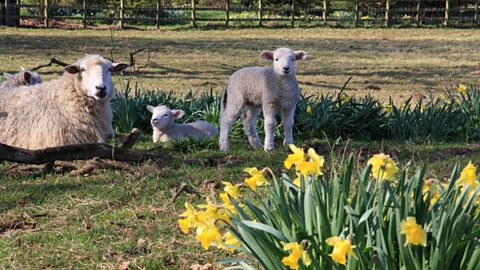
When does summer start?
- Summer in the UK is between June and August.
- Summer brings warmer weather and sunny days.
- Many of us spend more time outside.
- A lot of life thrives in the sun, so you will see plenty of wildlife and plants and trees in full blossom.
- Farmers use this time to maintain their crops for good growth.
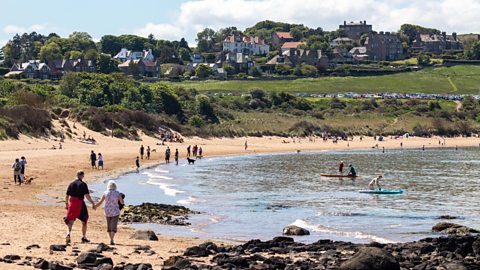
When does autumn start?
- Autumn in the UK is between September and November.
- Autumn brings cooler temperatures and shorter days.
- Many animals prepare to hibernationWhen an animal becomes inactive during the winter months to save energy. Their their breathing and heartrate slows down and their body temperature drops. in autumn by eating lots of food and finding a warm safe spot before winter.
- Some animals migrateMany animals, like birds or fish, move from one place to another at certain times of the year. Some animals migrate because the weather is too hot, too cold, too wet, or too dry during certain times of the year. from the UK to warmer places ahead of the cold winter.
- Farmers usually harvest their crops in autumn. Crops are taken to shops and supermarkets for people to buy or processed for people to eat all year round.
Learn more about how food makes its way from farms to our plates here: Food and health: Farm to plate
Why do leaves change colour in autumn?
- Autumn brings lots of beautiful colours, like oranges, reds, and yellows, for us to enjoy.
- The leaves of plants contain a chemical called chlorophyll that absorbs sunlight. This is what makes leaves green.
- Leaves contain lots of other coloured chemicals but there is much more of the green chlorophyll. The green colour is much stronger in spring and summer and hides the other colours.
- In autumn, the weather gets colder, the days get darker, and there is less sunlight for the leaves to absorb.
- deciduousTrees that lose their leaves once a year usually in the winter, such as oak trees. trees stop making new chlorophyll, so the leaves lose their green colour.
- When the green colour fades the other hidden colours are revealed: the oranges, reds, browns, and yellows that we see in autumn.
Learn more about different trees: Isla and Connor Explore Forests
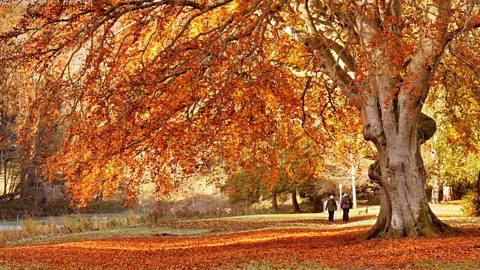
When does winter start?
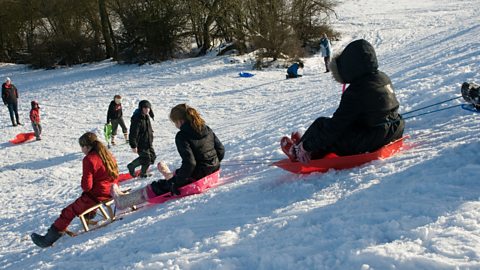
- Winter typically lasts from December to February and is the coldest of all the seasons.
- Our days are shorter in winter as we get less hours of sunlight throughout the day.
- Cooler temperatures mean we are more likely to get snow, ice and frost.
- We need to think about wrapping up warm with jackets, hats, scarves and gloves.

Winter wildlife in the UK
- There is a lot less wildlife and fewer plants in bloom to see. Many trees lose their leaves and a lot of animals migrate or hibernate in winter.
- However, there are some birds, trees and other plants that have adaptedWhen a plant or animal has changed to suit its environment. to thrive and survive in winter.
- Oak trees are dormantWhen a plant stops growing and saves its energy in preparation for cold temperatures, dry weather, or water and nutrient shortage. in winter but their seeds (acorns) need the cold temperatures in winter for their seeds to germinateWhen a seed begins to develop into a new young plant..
- Bulbs, like snowdrops and bluebells, also start growing in winter ready to flower in spring.
- Some birds, like fieldfares, redwings, bramblings, migrateMany animals, like birds or fish, move from one place to another at certain times of the year. Some animals migrate because the weather is too hot, too cold, too wet, or too dry during certain times of the year. to the UK in winter because it is even colder where they come from (places like Iceland and Scandinavia) and food is easier to find.
How does climate change affect seasons?
- Earth is going through a period of climate change. The atmosphereThe air that surrounds our planet. is heating up because of global heating and this is changing the weather, water levels and seasons.
- Our winters are getting warmer and wetter and our summers are getting hotter and drier.
- Climate change has also changed when seasons arrive. For example, the changes in weather and temperature that we associate with spring are often coming earlier in the year than they used to.
- These changes have a big impact on wildlife and food chains.

Key words about the seasons
- temperature - How we measure how hot or cold it is. We usually measure temperature in degrees Celsius.
- spawn - The eggs of an animal that lives in water, like fish and amphibians.
- crops - Plants that are grown for humans to eat, such as grain, vegetables, or fruit.
- migrate - When an animal travels from one place to another. This is usually because of changing seasons.
- hibernate - When an animal becomes inactive during the winter months to save energy. Their breathing and heartrate slows down and their body temperature drops.
- harvest - Gathering crops when they are fully grown and ready to store or eat.
Test your knowledge
Quiz
Test your knowledge of the seasons with this short multiple choice quiz.
Challenge

Create a poster about an animal who changes its behaviour when the seasons change.
Think about animals who hibernate or migrate when the seasons change. When do they do this? Why? How do they prepare?
What is migration? revision-guideWhat is migration?
As the seasons change, many animals move from one place to another. This is called migration. Learn more here.
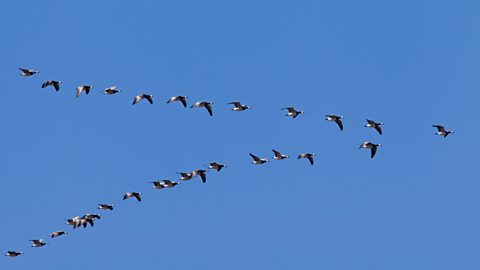
What is hibernation? revision-guideWhat is hibernation?
Find out why some animals hibernate when the seasons change.
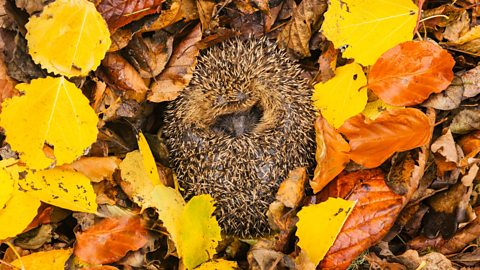
Spotting birds in winter with Rory Crawford. videoSpotting birds in winter with Rory Crawford
Rory Crawford goes on a winter walk to show us what birds we can spot during the winter months.

More about seasons
Seasonal food. revision-guideSeasonal food
Different seasons bring different kinds of weather. This affects the food we grow and eat. Find out more about seasonal food.
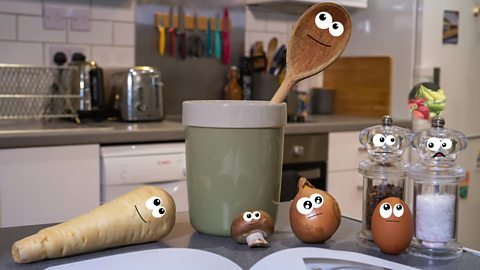
Why does weather change from season to season? revision-guideWhy does weather change from season to season?
Find out why the weather changes with the seasons.
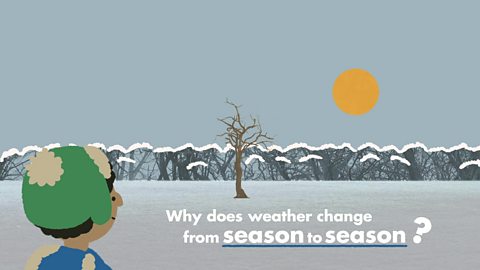
Seymour Science and the seasons. revision-guideSeymour Science and the seasons
Learn more about the four seasons and the changes they bring.
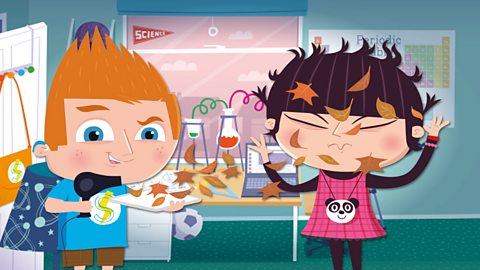
More on Weather
Find out more by working through a topic
- count13 of 24

- count14 of 24

- count16 of 24
